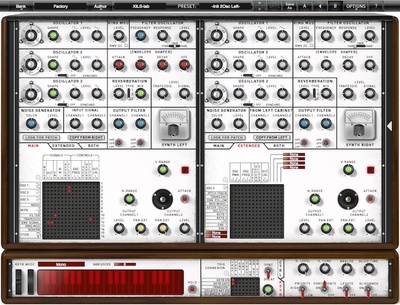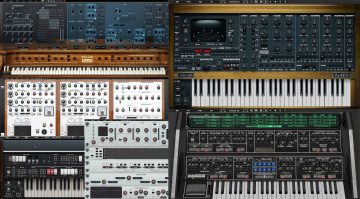British Giants: The History of EMS – On the run
EMS' synth designs are still influencing engineers today.
Before the 2600, before the SEM, before even the Minimoog, there was the VCS3. A modular synth in a tabletop package, this groundbreaking standalone synthesizer launched one of the most influential musical instrument companies ever, the very British Electronic Music Studios, or EMS. This is their highly experimental story.
The History Of EMS
Before anyone even knew what a computer was, some incredibly smart boffins were holed up in a studio in London in the late 1960s actually making music with them. They were geologist(!) and composer Peter Zinovieff, engineer David Cockerell and programmer Peter Grogno. The three soon hit upon the idea of making synthesizers to sell, and along with musique concrete film composer Tristam Cary, Electronic Music Studios was born.

Shortened to EMS, the small British company was, throughout its lifetime, much more involved with developing interesting and unusual prototypes than actual products. Their experimental background yielded, unsurprisingly, experimental results. And yet sometimes these odd instruments caught fire with musicians – so much so that we’re still talking about them more than 50 years later.
The History Of EMS: The Sound Of Your Childhood
For many British, the sound of EMS is the sound of their childhood. From their adoption by the BBC Radiophonic Workshop to their use by musicians like Pink Floyd, The Who and Jean-Michel Jarre, it’s almost impossible to overstate how influential EMS has been.
“British popular culture and EMS synthesizers go hand-in-hand,” said composer Alex Ball when we asked him about the company. “In the 1970s there were still only three TV channels, two of which were the BBC and so everyone watched the same shows. The BBC’s Radiophonic Workshop embraced EMS synthesizers and their giant (“Delaware”) Synthi 100 and VCS3 were staples of their soundtracks, notably Doctor Who. Combined with the fact that Pink Floyd and Roxy Music made prominent use of them, it was pretty difficult to not hear an EMS synthesizer in the UK at the time.”
The History Of EMS: Enter The Voltage Controlled Studio 3
In 1969, if you wanted to play around with a synthesizer, your options were largely limited to modulars by either Moog or Buchla. These were large, unwieldy beasts that were difficult to understand. EMS’s first instrument – and the one that changed everything – was the tabletop VCS3. The third iteration of their Voltage Controlled Studio Synthesizer instrument, it was no less unwieldy, beastly or difficult to understand than a Moog or Buchla but it was much smaller and, thanks to an ingenious pin matrix, had no cables at all despite being fully modular.

With its synthesis section (three oscillators, unique filter, Trapezoid envelope and so much more) up top and matrix and joystick at the bottom, it looked nothing at all like other synthesizers. It also had no keyboard. (This was rectified later on with the DK1 keyboard.) This, along with oscillator pitch instability, made it hard to play traditional tunes on, ensuring that it was used as a glorified sound effects box. But what glorious sound effects! Brian Eno was the king of this, feeding the instruments of his Roxy Music bandmates through it for live processing. Not to mention the BBC Radiophonic Workshop.
If you’re looking for the VCS3 experience in 2024, your best bet is Erica Synths’ wonderful Syntrx. XILS-Lab also does a mean software version, now updated as the VCS4.




The History Of EMS: It’s Got How Many Oscillators?!
For the follow-up to the VCS3, EMS decided to go big. Very big. The Synthi 100 has to be one of the biggest synthesizers ever made. Occupying an entire table, it had 12 oscillators, two noise generators, three ring modulators, four lowpass and four highpass filters, plus an additional 39 modules and even an oscilloscope. Based on VCS3 tech, it sounded incredible – and was also incredibly unreliable.
EMS managed to sell around 30 of them (they were outrageously expensive as you might imagine), with the one going to the BBC getting rinsed on the original radio broadcast of The Hitchhiker’s Guide to the Galaxy (yes, I’m aware my name is similar to Douglas Adams’) and of course, Doctor Who.
While there are no clones or remakes of the Synthi 100 out there, Analogue Solutions (whose Steve Gay once worked at EMS) has managed to recreate it in spirit as the Colossus.
The History Of EMS: Have Synthi Will Travel
The VCS3 may have been smaller than most modular systems but its unusual angled design resisted portability. To make it more gig-friendly, EMS reconfigured both modules and matrix/joystick areas into a single panel and packed it into a small suitcase. Dubbed the Synthi A, this was soon refreshed as the Synthi AKS with the addition of a membrane keyboard and sequencer in the lid of the case.

The Synthi AKS became something of a phenomenon. Everyone from Pink Floyd (that’s it on “On The Run” from Dark Side of the Moon) to Tangerine Dream to King Crimson bought one… or even multiples. It’s the sound of space rock, the ultimate crazy noisemaker.
If you’d rather have than a Synthi than a VCS3, try Arturia’s software version, Synthi V.

The History Of EMS: Listen To The Sound Of My Voice
By 1972, lead engineer David Cockerell was gone, having moved to America to work for Electro-Harmonix. Tim Orr then took over engineering duties, spearheading what was to be EMS’s last classic product. Released in 1976, Vocoder 5000 was an incredibly powerful voice changer with 22 bandpass filters and envelope followers as well as oscillators, noise and a frequency shifter. They were very expensive but also amazing-sounding.
If you absolutely must have the Vocoder 5000 sound, look no further than XILS-Lab’s software version, XILS Vocoder 5000.
Tim Orr later went on to work with kit company Powertran. It’s best known, of course, for the Transcendent 2000, the Joy Division synth.


This Is The End… Or Is It?
By the end of the 1970s, EMS was struggling. Peter Zinovieff had long since lost interest, preferring to work on his own music. In 1979, a company called Datanomics purchased the failing EMS. The Polysynthi, the revitalized company’s attempt at a polysynth, was lacklustre and disappointing.
Longtime EMS employee Robin Wood took over the company in 1982, acquiring full rights in 1995. He has been at the helm ever since. The company still has a web presence, although the site looks like it hasn’t been updated since 1998. I’d like to think he’s still putting together Synthi As and VCS3s, like he says on the site. If anyone has definitive information on the current status of EMS, let us know in the comments.
Update! According to a helpful reader, Robin Wood is indeed still building EMS VCS3 and Synthi A synths, although you’ll need to provide your own Spartantite case if you want an A. Contact Robin via email at the EMS site for more.
Thank you to Alex Ball for the use of the photos.
More Information
- EMS home page
- All about synthesizers
- All about modular
5 responses to “British Giants: The History of EMS – On the run”

You are currently viewing a placeholder content from Facebook. To access the actual content, click the button below. Please note that doing so will share data with third-party providers.
More InformationYou are currently viewing a placeholder content from Instagram. To access the actual content, click the button below. Please note that doing so will share data with third-party providers.
More InformationYou are currently viewing a placeholder content from X. To access the actual content, click the button below. Please note that doing so will share data with third-party providers.
More Information
 4,2 / 5,0 |
4,2 / 5,0 | 









EMS Rehberg in South Germany is still active. Ludwig Rehberg worked with Jean Michel Jarre and Boney M.
I’ve never found evidence of anyone successfully buying anything from him. I sent so many emails trying to buy a vocoder, a year later he replied asking for my physical address to send a catalog too… horrible communication… no thanks I’d never send him money. It’s a shame
Waiting for the Behringer VCS3 copy.
The Synthi 100 unreliable? There was a problem in the beginning, but then it worked great for many years. I loved it and could do amazing things with it.
Incorrect spelling of Tristram Cary’s name.
TristRam not Tristam